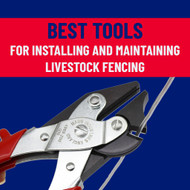Best Tools For Installing And Maintaining Livestock Fencing
3rd Apr 2023
The security of your livestock fencing is integral to keeping your animals safe and secure.
But the job of installing and maintaining it can be tough, particularly if your tools aren’t built for the job.
In this article, we go over our favourite tools for installing and maintaining farm fencing.
Best tools for each fencing job
Here we go over the best type of tool for each fencing task.
Fencing Pliers – Best for bending and cutting wire

Installing and repairing high tensile fencing wire is a rough job, that requires a durable tool that’s built for purpose.
This is where fencing pliers come in. They’re a combination plier that both bends and cuts metal wire in one easy to use hand tool.
Important features to look out for:
- High tensile fencing wire is tough, so choose fencing pliers with a heavy-duty shear type cutter, that’s rust-proof, high-leverage and hardened to at least HRC 62.
- A combination plier is best, that allows you to both cut and bend wire without swapping tools.
- Look for serrated jaws to keep a good grip on metal wire, even during bad weather.
- A v-slot in the plier jaws lets you feed and hold wire securely along the entire jaw length for extra grip.
Best choice: These fencing pliers from Maun are an excellent choice, with parallel jaws for an even better grip on wire, as well as a built-in heavy-duty cutter.
Post Hole Digger

A post hole digger is used to pre-dig the holes your fence posts will go in (particularly for the corner posts where a lot of the strain will be absorbed). They break up the ground and create a hole that’s wide enough for the post to be driven into.
The ideal post hole digger with be machine operated (e.g. using a tractor) as it will save you a lot of time and let you dig much deeper without the extra effort.
Here’s a great video example: Laying out our new pasture fencing
Wire Strainer
You can pull single lines of fencing wire tight against a post with your fencing pliers (see above).
However, if you’re doing a long line of woven wire fencing, then you will likely want to tension it all at once, which can be done with a tractor and a wire strainer. Here’s an example of a stretch of wire fencing being tensioned using a tractor.
That video goes over how the wire mesh is dragged along the length of the fence, before the roll is locked off from moving, then the tractor drives forwards slightly to apply tension across the line of fence – from which point it can be stapled in place.
Post Drivers

If you’re installing posts without a post hole digger, then you’ll need a post driver to ensure you embed the post deep enough in the ground to remain secure. These tools sit on top of the post, where you then lift and drive them down onto the post to push them into the ground.
You can now get petrol powered post drivers, which will seriously save your arms over a long stretch of fencing.
Hammer

It goes without saying really, but you will need a solid hammer and fencing staples to attach the wire to the posts.
You should hammer your staples in at different angles along the height of the post, to stop them from splitting in the same places.
Types of Fencing
Electric, woven wire and barbed wire are all popular types of fencing, but they aren’t appropriate for every situation.
Electric fencing is ideal for large animals in a controlled area, but can be more expensive and require more maintenance than other options – it’s easily shorted out by interference with the wire and requires regular checks for proper voltage.
Barbed wire fencing is a strong and low-cost option, but it can result in injury if predators enter your animals’ fields. It’s commonly used to fence off cattle.
Woven wire fencing is a good option for smaller animals, as it prevents them squeezing through the fence and can be embedded in the ground to prevent animals digging under it. However, it’s not as strong as other options, so isn’t always appropriate for larger animals.
Conclusion
We hope you enjoyed our post on the best tools for livestock fencing.
Browse our related posts below, or contact us with any questions:

